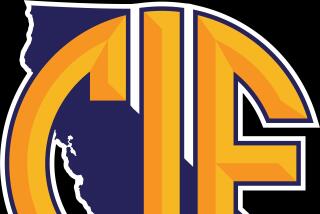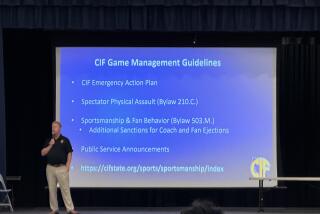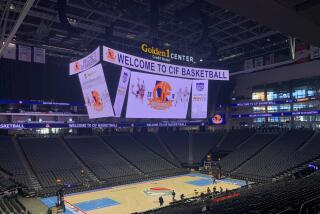Doctors Reexamine the Process
For 20 years, football players from Encino Crespi High lined the hallways and crowded the examination rooms of Dr. Richard Ferkelâs Van Nuys medical office on a Saturday in August for what had become a rite of summer: an assembly line-style medical screening that allowed them to participate in sports.
Usually lasting no more than a few minutes per player and performed for a nominal fee, the screenings were popular for convenience--and because they almost always ended with the doctor signing medical clearance forms required annually from each athlete by the California Interscholastic Federation.
But this summer, Ferkel, an orthopedic surgeon, joined a growing number of physicians who are avoiding medical screenings or are limiting their participation in them. Because of health and liability concerns heightened by a spate of deaths and catastrophic injuries in recent years, he no longer welcomes the responsibility of checking body systems outside his specialty.
âMany years ago, I think [specialists] were more comfortable with doing everything,â Ferkel said. âBut that has changed.â
Last year, 17 high school and junior high football players died, according to the National Center for Catastrophic Sport Injury Research at the University of North Carolina. That equaled the highest number since 1976, when there were 22 deaths.
Six of last yearâs football deaths were attributed to heart problems, including that of Jonathan Diaz, a 17-year-old lineman from Wilmington Banning High who went into cardiac arrest during a practice. He had failed a preseason health examination and had been cleared to play not long before he was stricken..
Cross-country runner Jason Kortekaas, 17, of Victorville Silverado and soccer player Ryan King, 16, of Manhattan Beach Mira Costa also died last year of heart ailments.
Heart conditions, which can be difficult to detect, are of particular concern to the many orthopedists and chiropractors who are team doctors and have been annually called on to perform screenings.
â[The screenings] help find things that are in a moderate or severe state [of damage],â said Dr. Mel Hayashi, an orthopedic specialist and longtime football team doctor for Newbury Park High, Moorpark College and Cal Lutheran University. â ... [But] with heart problems itâs hard. Things like arrhythmia problems are subtle. We canât pick those up on our exams.â
Though short in duration, a typical screening includes a wide range of checks: The heart and lungs are monitored with a stethoscope; there is a short discussion about the athleteâs medical history; height, weight, blood pressure and pulse rates are measured, and brief orthopedic checks of the strength and flexibility of the limbs and spine are made. Some examinations also include vision tests and checks of the ears, nose, throat and abdominal cavity, leaving some specialists worried that theyâre straying too far from their areas of expertise.
âThe danger is missing something,â said Jerry Bornstein, a retired orthopedist who assigns game-day medical personnel for about 25 schools in the San Fernando Valley. âYou miss one kid and thatâs the kid you read about.â
As a result, even doctors who enjoy working the sidelines as team physicians on game nights are among those who wonât participate in medical screenings. Echoing Ferkelâs concerns, Dr. Mark Getelman, an orthopedist who has worked with the Thousand Oaks football team for 10 years, said he was âhappy to clear athletes from an orthopedic point of view,â but âwasnât comfortable doing it with the heart, lungs and a lot of the other things that are required.â
There are two major considerations: The quality of care--cited most often by specialists as the reason they are hesitant to take part in screenings; and liability--the factor most often mentioned by coaches and athletic directors as the reason specialists are increasingly wary.
Liability is an issue because malpractice insurers may exclude a procedure from coverage or limit coverage, based on a wide variety of factors. Ferkel said liability concerns were a âminor considerationâ in his decision not to provide screenings this year.
But several school officials said theyâre convinced liability worries sideline many physicians who would otherwise be willing to help.
âItâs not the risk of injuries,â said Jon Mack, football coach at Ventura St. Bonaventure. âItâs the risk of lawsuits.â
Move That Line
At Corona del Mar Highâs annual all-sports screening session in June, two orthopedic specialists provided on-the-spot medical clearance for all but four of the 126 athletes they saw in examinations that usually lasted less than five minutes.
A case of asthma, a skeletal disorder, a shoulder injury and an injured knee were referred for further evaluation.
âThis is by no means, nor is it intended to be, a full, complete physical,â cautioned Dr. Michael Gordon, one of the participating physicians. âThese screenings are for obvious things.â
Meggan Stockstill, whose son, Beau, plays water polo and baseball for Corona del Mar, said she considers the process âa rubber stamp,â adding, âI donât depend on it.â
However, in the absence of regular health care, some athletes do depend on screenings.
âI donât have a regular doctor, so I just come here,â said Tejay Lord, a running back on the Dorsey High football team who attended a free screening this month at Orthopedic Hospital of Los Angeles.
For others, time is an issue. âDuring the week, I work Monday through Friday,â said Kimberly King, whose son, Michael Carr, plays linebacker for Dorsey. âBy the time I get off work, these guys would be closed. Itâs not always easy to get time off, and some people canât afford to take it.â
Aware that the screenings are the only health care some athletes might receive in a year, doctors attempt to ensure that athletes and parents know what theyâre getting--and not getting--during the exams.
Time constraints--keeping that long line moving--only add to their difficulty. âWhen you look at the volume of kids ... thereâs an apathy that comes into play, and you almost get dulled by it,â said Dr. John Dingilian, a family practitioner who is the football team physician for Granada Hills High.
Said Dr. Gregg Hartman, an orthopedic specialist who helped screen 220 athletes from Royal and Simi Valley highs: âIâm going through too many kids too fast. Weâre looking for red flags, really.â
The fear of a rushed examination was the reason several parents cited as to why they take their young athletes to the family physician each year.
Joanne Mooreland sent her son, Westlake High tight end Will Faul, to a screening when he was a freshman. Now a senior, he hasnât been back.
âIt just seemed like he was part of the pack,â she said. âI just felt like we got rushed through. This way, I donât worry when heâs out there [playing], because I know heâs been checked out. I like the attention better, and if there is, in fact, anything wrong with him, Iâd rather have it on record with our doctor.â
Suggesting a Cure
As long as the CIF demands all athletes receive annual medical clearance--a mandate that isnât likely to change--screenings will probably remain part of the high school sports landscape. So the question becomes how to make them more effective.
The dozen or so doctors interviewed for this story are largely in agreement on some safeguards they say would improve the process:
* Standardize the authorization form. The CIF recommends schools use a release form that was developed five years ago in a cooperative effort among five nationally recognized health and sports medicine organizations. The form includes a checklist of 16 personal medical-history questions that doctors say can be keys in identifying potential health problems, and it is already required by some districts, including Los Angeles Unified. This fall, the CIF is expected to take the first step toward requiring that all schools use the same form, a move welcomed by many medical practitioners.
* Be more selective. Chiropractors have long volunteered their services in the absence of other medical professionals, but this year the Oxnard School District said it wouldnât accept a physical performed by anyone other than a medical doctor. LAUSD requires that examinations be performed either by a physician or a physicianâs assistant with the doctor co-signing--and it asks school nurses to become familiar with local doctorsâ signatures and double-check clearance forms they suspect might be falsified. Stamps with the physicianâs license number, location, phone numbers and other pertinent information must be on the form along with the signature.
* Organize teams of specialists. A orthopedist stretches beyond his level of expertise if he is the only physician at a screening. But combine an orthopedist working with a pediatrician, an internist and a cardiologist, and you have an improved system. âItâs best for everybody to let the experts handle their areas,â Getelman said.
Several hospitals and clinics already offer low-cost or free medical screenings for athletes from schools in their areas, so the trick would be to find more general practitioners and a broader range of specialists who are willing to work them as a team.
Until that happens, individual specialists who work screenings walk a tightrope, balancing their desire to help with the risk of making a costly mistake.
Said Hartman, the Simi Valley orthopedist: âWhen a season ends with no major injuries, every time that happens itâs a big sigh of relief.â
More to Read
Go beyond the scoreboard
Get the latest on L.A.'s teams in the daily Sports Report newsletter.
You may occasionally receive promotional content from the Los Angeles Times.










